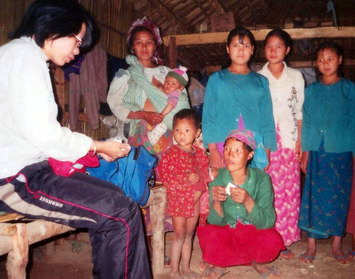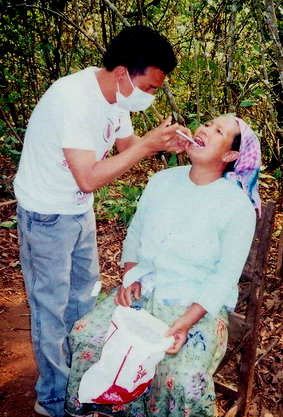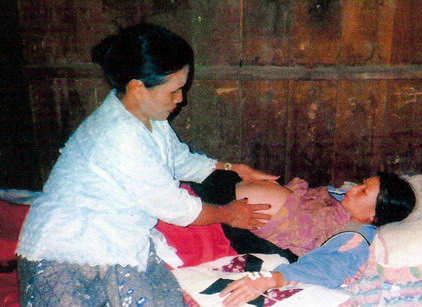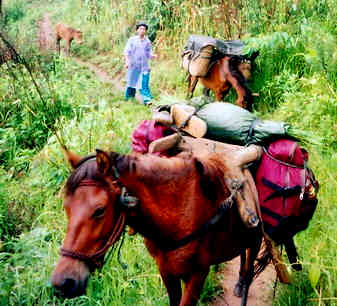|
|
Report Summary: This Lahu FBR team recently returned from a humanitarian relief mission to assist people in a Lahu ethnic area of the Shan State, Burma. The Lahu are one of the many ethnic peoples of Burma and live primarily in the Shan State of Burma.
The Lahu people live under the oppression of the Burma Army and are often caught in the fighting between the Burma Army and Shan pro-democratic resistance (SSA). They also suffer under the hands of some Lahu militia forces that have allied themselves with the Burma Army. This report documents the situation for some Lahu people and the challenges they face. The Lahu, like all people in Burma, long to be free and to live in dignity. They have not given up and the FBR and other Lahu organizations work together with them for freedom, justice and peace.

pregnant women come for treatment

Lahu FBR medic treating dental patient

Lahu medic caring for pregnant woman

horses transport relief supplies
1) Team Meeting.
1) In March 2006, Lahu Relief Team had a meeting for the trip and met local authorities and received permission to administer medical treatment and security in the field.
2) In July 2006, we evaluated our trip and discussed plans for the next trip.
2) Objectives of FBR (Lahu)
– To express human rights violation
– To help poor people and IDPs
– To give free medical treatment
– To teach Lahu literature and set up primary schools for Lahu children
– To share God’s love
3) The team members on this trip
1. Team Leader
2. Medic
3. Medic
4. Health worker
5. Documentation
6. Organizer
7. Communicator
4) Documentation
Human Rights Violation in Lahu Areas
Lahu people are living under the military control of the SPDC, UWSA and Lahu militia groups who continually violate the ethnic peoples’ human rights.
a) Lahu Couple Arrested and Fined by Lahu Militia Group.
Law Law and wife Na Na are living in Law Je village, in the Keng Tung area. Lahu militia groups are in control of this area. One day, the couple had a quarrel with each other. The following day the militia leader Poe Khin called them to Ha Hpu Ma village. The couple had already resolved their differences. However, when they went to Ha Hpu Ma village, Poe Khin ordered his soldiers to put the couple in leg stocks under the house. After three days, they were forced to sell their cow and pay 60 silver coins (330,000 kyats) to Poe Khin, after which they were released. In cases like these, the village headman is able to solve the problem, but the Lahu militia group unfairly arrests and fines villagers without regard to traditional justice.
b) Akha Woman Beaten by Soldier of Lahu Militia Group
In June 2006, an Akha woman was beaten by a soldier from a Lahu militia group named Ah Meu. His responsibility is to collect the money from the villagers and pay both the militia and the Burma Army. He usually collects more than the militia leader and the Burma Army order. One day, he went to an Akha house and ordered the inhabitants to pay taxes to the Burma Army. The Akha woman told him they had already paid yesterday, that she had no money, and if they wanted to talk to her husband they would have to wait until he returned from the paddy fields. Ah Meu then beat her with his gun and kicked her while she was on the ground. Then, the Akha women came to Mai Khu police camp and complained about her treatment. The police referred the case to the leader of the Lahu militia group. The Lahu militia leader did not take any action against Ah Meu. They only gave him a warning and he was asked to pay the medicine fee for the Akha woman. However she said she did not receive any money from Ah Meu. A Lahu medical team met the woman one week later and gave her medical treatment.
Note: The Akha are an ethnic people in Burma who frequently live very close to Lahu villages.
c) Repeated Violations by Burma Army soldiers Unpunished
Ah Meu has repeatedly used violence and force against villagers. The Lahu militia leaders and Burmese Army also do not punish him for his violations because he normally collects taxes and other fees for them. The villagers told the Lahu Relief Team about these violations. In May 2006, villagers were preparing their paddy fields. One day, a villager’s buffalo entered Ah Meu’s paddy field. Ah Meu shot and killed the buffalo. After that, he paid only half of the buffalo’s value and he did not return the buffalo meat to the owner, as is the traditional practice.
d) A Lahu girl was raped by her step father
In April 2006, Lahu girl Na Teh (not her real name), 15 years old, was raped by her stepfather who was later was put in Keng Tung Jail. The details are as follows: the village head man used to be a soldier of United Wa State Army (UWSA) based in Mai Zin village, Keng Tung area. Twelve years ago, he married Na Teh’s mother when Na Teh was 4 years old. After they married, Na Teh treated him as her real father. Earlier this year, the stepfather began to change his relationship with his daughter, making romantic and physical advances towards her. One day, when they reached the paddy field, he touched his knife to his daughter’s neck and raped her. Na Teh told her mother and she was very angry with her husband but she was very afraid of him. Na Teh was then raped several more times. The stepfather was suspicious of his wife because of her anger, and thus constantly watched Na Teh and his wife. He did not allow them to go to other people’s houses. One day, Na Teh and her mother told him to buy medicine in the village. While he was gone they came to Mai Khu police station and complained to the police. They also brought the knife used to threaten the Na Teh as proof of their story. The police went to the village and arrested him. At the same time, Na Teh’s mother sold her paddy field and paid the local authority and the police in order for them to prosecute her husband and place him permanently in jail. Without paying bribes and other unofficial fees, it is very difficult for average villagers to get proper assistance from the authorities.
e) Forced Labor
There are many reports of people across the whole country forced to plant “Kyet Su Pin” trees for government income. This includes the villagers living in Mai Khu, Mai Pa and Na In villages who were forced to plant the trees by the Burma Army.
In April 2006, Army Artillery Unit (909) led by Maj. His Tung Soe, and LIB 244 led by Maj. Soe Win Maung, based in Mai Khu area, ordered the villagers to move their cemeteries to other places so that they could occupy the area and plant more Kyet Su Pin. The family members and relatives were forced to remove the corpses from the tombs. After that, the army ordered them to clear the area and prepare to plant the trees again. Then, Burmese soldiers and their families came to the village to celebrate the planting of the trees. Before the planting of the trees the army said, “This is income for the villages, not for us.” After planting, they said, “This is income for our army.” At that time the villagers were facing many difficulties because they were busy planting their paddy fields. While the men went to the fields, the women and children were made to work on the Kyet Su Pin instead of helping with the paddy as usual. If they could not work in the daytime, they had to work in the evening time. The Burmese soldiers watched with their guns.
We are sending a 7-minute video CD. In this video Lahu and Akha villagers are seen forced to plant the “Kyet Su Pin” in Mai Khu area.
5) Itinerary of Lahu Relief Team MIssion (April June 2006)
The mission was conducted from March 30, 2006 through July 9, 2006 in the Keng Tung area of Shan State, Burma.
Documentation
– Our team is giving treatment and doing documentation. We will continue this on the next trip .
Future Plan:
– We will commence a long mission trip giving medical treatment and performing documentation inside Burma from September 2006- January 2007.
– We hope that we can send more information about human rights violations in Shan State on the next and we will be trying our best.
– We will produce two Videos, one is music and another is about Lahu people in Burma. The background voice will speak Lahu languages and we will put subtitles in English.
– We are still collecting information about Lahu in Burma because they are a little different according to their places.
6) Educational situation in Lahu Areas
a) Activities on Education:
– We continue teaching Lahu literature in three villages inside Burma. Some villagers can read and write Lahu literature and also the two primary schools in our target areas, are still functioning.
– Two school buildings are finished and school opened on 1st June 2006.
– We taught the children songs, personal hygiene, and told them stories during our field visit in the summer time.
– We met school teachers and shared teaching methods.
b) Needs for education service and program:
– We need to support teachers, more teaching materials and sports equipments for children. Children asked to bring painting books and story books for them next time.
c) Future Plans for education program:
– These two schools are still running. Students increase year by year, thus we need more financial aid to support schools.
7) Health Situation in Lahu Areas
a) Activities on Healthcare:
– On 2 11 June 2006, our team conducted a health education training at the Thai Burma border. There were 20 participants in that training.
– We divided into two or three groups and went to 20 villages giving health education and giving medical treatment to patients in Keng Tung and Mai Pyant Areas. There are (40) child patients and (110) are adult patients. The most common diseases are malaria, cough, tooth problems and Gastric etc. We attached a patients list in the attached figure.
– We distributed vitamin A and de-worming medicine for (70) students of three schools in June.
We have a plan to do training for Traditional Birth Attendant (TBA) with the Back Pack Team.
b) Need for Healthcare:
– We need to give more health education among the villagers and still need health posters, magazines and pamphlets, etc. in the Lahu Language.
– Need rain coats and long rain shoes for team in the raining season.
c) Future Plan for Healthcare:
– Our team will continue medical treatment in Eastern Shan state. We are also praying and trying to open a center for recovery and education for drug users.
d) Request to FBR:
– We gave some medicine and continue to, but we still need more medicine.
8) Groups Networked with:
We are networking the following Organizations.
– Free Burma Rangers
– National Democratic Front
– Lahu Democratic Front
– Lahu Women Organization
– Mae Tao Clinic
– Back Pack Health Worker Team
– Local authorities
9) Sharing God’s love
– We also continue sharing God’s love with those we meet. (Many Lahu people live in fear of evil spirits and want to hear aobt God who can free them). 33 peoples (from Law Je village) became Christians- they were Animist. Some asked to be baptized so we celebrated the Baptism on 2 3 Apr 2006 at Law Je village. Also 4 other Lahu evangelists to preach the gospel for non believers.
– A member had been to Lahu Mission School based in Ho Tao, China Burma border in June and teaching the Bible, gospel songs, leadership and management in the Church. There are 45 students learning the Bible and 5 teachers there. That area is control by UWSA.
Need: We still need more finance, praying and servants to fulfill our mission .
Future Plan: To continue in the old areas and to go to new areas in Mai Ping to preach gospel.
Security: The security is not so bad. While we went to Nan Pan areas, Burmese troops around the village and SSA also entered the villages. Sometimes, our team had to avoid two troops with the villagers because the Lahu militia and SSA were shooting around Law Ce village in April.
10) Security Problems
– On April 2006, Shan State Army (SSA) and Lahu Militia groups were fighting near Law Je village Keng Tung area. We avoided this with the villagers in their paddy field.
11) Evaluation of the whole trip
Strong Points
– Coordinated and consulted the area authority and village headmen.
– The villagers trust us and invited us to come again. They provided food for us.
– We got a new experiences and learned what we have weak points.
– We went to some villages for field visiting and learned the situation of Lahu, Akan and Shan people.
Weak points or problems
– The delay in sending this report to FBR is the result of computer problems. If FBR can provide a better computer, it will be very helpful for the future.
– We have not enough medics to accommodate the abundance of patients.
– Need to practice video record and editing
Thank you and God bless you,
A Lahu Free Burma Ranger team
ENDS
